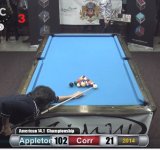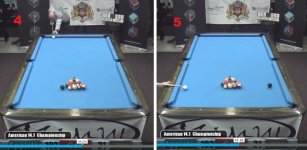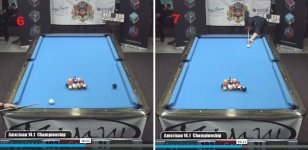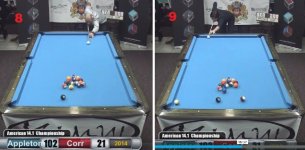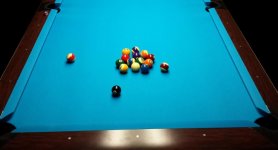Diamond Billiards did a great thing by live streaming their straight pool tournament last weekend, and then posting some of the matches for replay.
I watched the finals between Corr and Appleton and of course they are both top notch, first class level players. However, I found that the safety battle near the end of the match was surprisingly one dimensional. My purpose with this post is not to try and criticize world class players (well, I guess I am doing that), but to see if I have really learned anything about safety battles -- from Stu in particular. I would like to go through each safety shot explaining what I think is wrong, and what a better alternative would have been. I think I will learn more from your various replies that way.
Unfortunately I had to post all the photos at the bottom of this post, so you might have to scroll up and down a bunch of times to see what I am talking about. Also, if you want to view the actual safety battle you can find it here (starting at about 43:20):
http://vimeo.com/106301897
The overall comment I have is that both players seem to be relying too heavily on only one safety strategy: "put a lot of space between the cue ball and the rest of the balls." This is only one strategy, and I believe is one that is mostly used when there are no other alternatives.
Stu likes to talk about "developing threats." Like in chess, the war is won a bit at a time, not all in one battle. Developing threats is the process of moving balls into the open one or two at a time while at the same time not allowing your opponent to have a shot on those balls. Eventually it will be nearly impossible for your opponent to leave you without a shot if you have done things perfectly. I don't see any of that in this safety contest.
PHOTO 1
This begins the safety contest. Corr has gotten straight on her break ball and decided to play safe by pocketing the break ball and drawing back to the head rail. IMO the correct play here is to pocket the ball and roll ahead about a ball diameter. Take the point. Then, play a "second ball" safety by shooting into the 5 ball. This is a standard "bread and butter" 14.1 safety play that scatters balls nicely and freezes the cue ball...tough to get out of. Corr had the opportunity to take an offensive position in the safety play with the second ball safety, instead, she passed on the opportunity and left things neutral.
PHOTO 2 shows what Appleton is left with.
PHOTO 3
In this photo Appleton has already taken a "back scratch" by going two rails and into the back of the rack, which was the correct shot. He almost misplayed the shot by not freezing the cue ball to the back of the pack. Corr is in the process of grazing the 15 and going to the head of the table, which I believe is another mistake.
I've heard two HOF players say to "never, never, ever, ever, never.....ever" graze a corner ball and send the cue ball uptable. There is too great a risk of creating a dead combination into one of the near corner pockets. You can see the 12 and 13 balls move after she hits the shot, and the first thing Appleton does is walk over and scrutinize those balls for something dead.
I think she could have shot the cue ball towards the left side rail, nicking the 15 in the process and leaving the cue ball either near the left corner pocket, or somewhere that she isn't leaving a shot on the 8 ball.
PHOTO 4
So Corr gets away with it and hits a shot with nice speed, leaving him on the rail. Appleton does the right thing and even develops the 8 to his advantage from a difficult position (seen in photo 5).
PHOTO 5
If the bottom row of balls were frozen, it could have been a nice opportunity to open more balls up (more threats) while freezing on the 11, but in fairness I don't think that was possible here. Corr does about all she can from this situation.
PHOTO 6
I think Appleton takes the wrong shot here. He again uses the strategy of putting the cue ball far away from the object balls. In the process, though, he sends the 8 into the pack and it NEARLY freezes dead into the corner pocket (see photo 7). Against someone like Corr, that could have been a serious turning point in the match. The 11 on the other side of the pack was disturbed by the 8 ball contact and could have been made dead in the corner off the 6, although it wasn't.
I think he should have thinned the right side of the 8, sending it to the middle region of the table while hiding the cue ball either nestled in the pack, or hidden just below it. In either case, there is no risk of creating a dead combination.
PHOTO 7
Again, Corr thins the 8 in order to send the cue ball back uptable away from the other balls. She disturbs the rack in the process and just look at the 15 ball. It moves backwards and comes within an eyelash of being dead in the corner. Appleton takes a second look for dead balls.
I think she might have been wise to take a 1 rail back scratch with right english. In other words, don't try to thin the 8. Just reset your strategy by taking a scratch and snugging up against the 9 and 2 without moving a lot of balls apart (after all you are on 1 foul and your opponent can just tap the cue ball if you make things too difficult).
PHOTO 8
Appleton loses the safety battle on this shot. Again, he is using the same strategy...keep the cue ball far away from the other balls. He hits too fat and pops the 9 ball out as a hanger. Maybe the better option is to back scratch as in photo 7. You just have to be careful about not leaving a shot on the 8.
PHOTO 9
This shows the result of Appleton's safety. Corr misses, probably due to fatigue, but she still won the safety contest.
After looking through these shots in more detail, I think Corr's shot in Photo 7 was potentially the most devastating. That 15 ball moves backwards almost in perfect position to be dead off the 5 in the corner.
When you remove the "thin a ball and send the cue ball uptable" shot from your thinking, it opens up other interesting possibilities. I can't say there is NEVER a time for a shot like that, but then who am I to argue with HOF straight pool players?
I'm interested to hear comments!
I watched the finals between Corr and Appleton and of course they are both top notch, first class level players. However, I found that the safety battle near the end of the match was surprisingly one dimensional. My purpose with this post is not to try and criticize world class players (well, I guess I am doing that), but to see if I have really learned anything about safety battles -- from Stu in particular. I would like to go through each safety shot explaining what I think is wrong, and what a better alternative would have been. I think I will learn more from your various replies that way.
Unfortunately I had to post all the photos at the bottom of this post, so you might have to scroll up and down a bunch of times to see what I am talking about. Also, if you want to view the actual safety battle you can find it here (starting at about 43:20):
http://vimeo.com/106301897
The overall comment I have is that both players seem to be relying too heavily on only one safety strategy: "put a lot of space between the cue ball and the rest of the balls." This is only one strategy, and I believe is one that is mostly used when there are no other alternatives.
Stu likes to talk about "developing threats." Like in chess, the war is won a bit at a time, not all in one battle. Developing threats is the process of moving balls into the open one or two at a time while at the same time not allowing your opponent to have a shot on those balls. Eventually it will be nearly impossible for your opponent to leave you without a shot if you have done things perfectly. I don't see any of that in this safety contest.
PHOTO 1
This begins the safety contest. Corr has gotten straight on her break ball and decided to play safe by pocketing the break ball and drawing back to the head rail. IMO the correct play here is to pocket the ball and roll ahead about a ball diameter. Take the point. Then, play a "second ball" safety by shooting into the 5 ball. This is a standard "bread and butter" 14.1 safety play that scatters balls nicely and freezes the cue ball...tough to get out of. Corr had the opportunity to take an offensive position in the safety play with the second ball safety, instead, she passed on the opportunity and left things neutral.
PHOTO 2 shows what Appleton is left with.
PHOTO 3
In this photo Appleton has already taken a "back scratch" by going two rails and into the back of the rack, which was the correct shot. He almost misplayed the shot by not freezing the cue ball to the back of the pack. Corr is in the process of grazing the 15 and going to the head of the table, which I believe is another mistake.
I've heard two HOF players say to "never, never, ever, ever, never.....ever" graze a corner ball and send the cue ball uptable. There is too great a risk of creating a dead combination into one of the near corner pockets. You can see the 12 and 13 balls move after she hits the shot, and the first thing Appleton does is walk over and scrutinize those balls for something dead.
I think she could have shot the cue ball towards the left side rail, nicking the 15 in the process and leaving the cue ball either near the left corner pocket, or somewhere that she isn't leaving a shot on the 8 ball.
PHOTO 4
So Corr gets away with it and hits a shot with nice speed, leaving him on the rail. Appleton does the right thing and even develops the 8 to his advantage from a difficult position (seen in photo 5).
PHOTO 5
If the bottom row of balls were frozen, it could have been a nice opportunity to open more balls up (more threats) while freezing on the 11, but in fairness I don't think that was possible here. Corr does about all she can from this situation.
PHOTO 6
I think Appleton takes the wrong shot here. He again uses the strategy of putting the cue ball far away from the object balls. In the process, though, he sends the 8 into the pack and it NEARLY freezes dead into the corner pocket (see photo 7). Against someone like Corr, that could have been a serious turning point in the match. The 11 on the other side of the pack was disturbed by the 8 ball contact and could have been made dead in the corner off the 6, although it wasn't.
I think he should have thinned the right side of the 8, sending it to the middle region of the table while hiding the cue ball either nestled in the pack, or hidden just below it. In either case, there is no risk of creating a dead combination.
PHOTO 7
Again, Corr thins the 8 in order to send the cue ball back uptable away from the other balls. She disturbs the rack in the process and just look at the 15 ball. It moves backwards and comes within an eyelash of being dead in the corner. Appleton takes a second look for dead balls.
I think she might have been wise to take a 1 rail back scratch with right english. In other words, don't try to thin the 8. Just reset your strategy by taking a scratch and snugging up against the 9 and 2 without moving a lot of balls apart (after all you are on 1 foul and your opponent can just tap the cue ball if you make things too difficult).
PHOTO 8
Appleton loses the safety battle on this shot. Again, he is using the same strategy...keep the cue ball far away from the other balls. He hits too fat and pops the 9 ball out as a hanger. Maybe the better option is to back scratch as in photo 7. You just have to be careful about not leaving a shot on the 8.
PHOTO 9
This shows the result of Appleton's safety. Corr misses, probably due to fatigue, but she still won the safety contest.
After looking through these shots in more detail, I think Corr's shot in Photo 7 was potentially the most devastating. That 15 ball moves backwards almost in perfect position to be dead off the 5 in the corner.
When you remove the "thin a ball and send the cue ball uptable" shot from your thinking, it opens up other interesting possibilities. I can't say there is NEVER a time for a shot like that, but then who am I to argue with HOF straight pool players?
I'm interested to hear comments!

